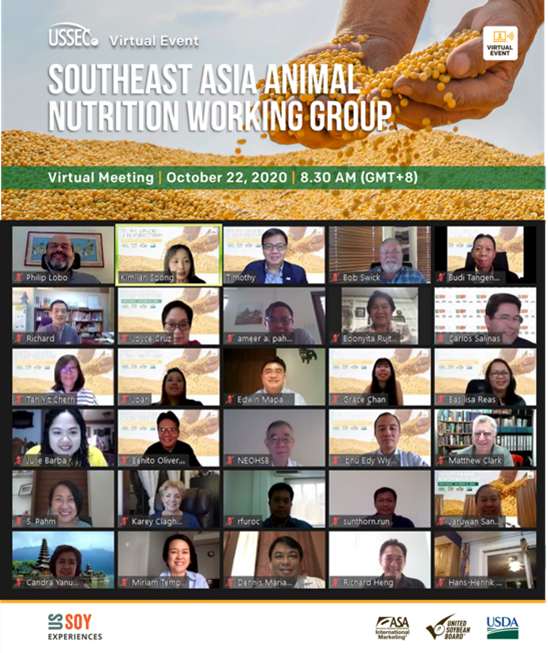
Helping Southeast Asia Animal Nutritionists Realize the Value of U.S. Soybean Meal
The 3rd Southeast Asia Animal Nutrition Working Group brought together key industry professionals and technicians for a roundtable discussion on getting the most out of their feed ingredients, particularly soybean meal, to achieve optimal animal performance at the lowest cost.
Southeast Asia, following the objectives set up by the United Soybean Board’s (USB) Animal Nutrition Working Group (ANWG) in the United States, established a regional animal nutrition working group in 2018. The SEA ANWG aims to bring together a select group of senior technical professionals from major agribusinesses in the region for an annual roundtable discussion to exchange ideas and knowledge, as well as share issues and concerns, on animal health, feed technology, and other key topics for the benefit and betterment of the industry as a whole. As such, U.S. Soy’s role in growing Southeast Asia’s animal nutrition industry and the use of soybean meal as a primary feed ingredient is prominent and discussions often chart future research priorities for the region.
45 participants from 12 countries met virtually during the 3rd SEA ANWG on October 22. 26 senior technical professionals from Southeast Asia’s animal nutrition industry took part, as well as 19 speakers and USSEC representatives. Attendees hailed from Indonesia, Malaysia, Myanmar, Philippines, Thailand, and Vietnam.
USSEC Regional Director – Southeast Asia Timothy Loh opened the program and chaired the industry outlook session. Philip Lobo, USB director of feed utilization, spoke about current USB research and programs impacting animal and feed producers in Asia. Carlos Salinas, USSEC global research committee director and regional director for the Americas region, shared soybean supply and demand figures for 2021 and the ongoing USSEC global research projects efforts that demonstrate USSEC’s commitment to the industry.
The second session, chaired by Dr. Basilisa Reas, included a segment on the state of the animal nutrition and feed production industry, where representatives from each of the six Southeast Asia countries shared technical/animal nutrition issues that affected the feed and animal industries in their respective countries. African Swine Fever (ASF) and COVID-19 remained the top concerns of the region’s animal feed and nutrition industry. Dr. Hans Stein, University of Illinois, and Dr. Robert Swick, professor and researcher at the University of New England Armadale, spoke about “Formulating Using Net Energy in Pigs” and “Low Protein Diet; How Low is Most Efficient” focusing on energy and protein amino acid.
In the third session, chaired by Dr. Benito Oliveros, partial findings of an ongoing survey on soybean and soybean meal usage in the Philippines were shared by Dr. Sarah C. Pahm, who affirmed that more than 70% of the Filipino feed producers surveyed purchase U.S. soybean meal as they observed higher nutrient values and superior quality consistency compared with other origins. The finding was further evident in a comparison presented by Dr. Markus Martin of Evonik Europe, where near infrared (NIR) analysis of thousands of soybean meal samples from different origins were collected at destination countries globally.
During the discussion segment on “How Nutritionists Value Soy,” participants shared how they, as nutritionists, value soybean meal in their feed formulation and openly discussed practical and hands-on experiences in determining soy quality. While recognizing that U.S. soybean meal has higher nutrient values, price and economics still play a role in decision making especially in countries such Thailand, Indonesia, Malaysia, and Myanmar.
The fourth and final session, chaired by Dr. Budi Tangendjaja, reinforced the higher energy content in U.S. soybean meal. Dr. Gonzalo Mateos, professor of animal science at the University of Madrid, suggested that based on his meta-analysis, U.S. soybean meal, which has a higher sugar content, would translate to higher energy content as every percentage of sugar in soybean meal would correspond to an additional of 20 kcal per kg energy. His comment was further supported by Matthew Clark of Genesis Feed Technologies who demonstrated the soybean Nutrient Value Calculator, an innovative tool that participants were encouraged to use in their soybean meal purchasing and feed formulation. The closing segment, facilitated by Timothy Loh, discussed the conclusions of the meeting and also future research prospects and studies that can help the Southeast Asia animal nutrition industry get the most out of their feed ingredients, in particular soybean meal, to achieve optimal animal performance at least cost.
